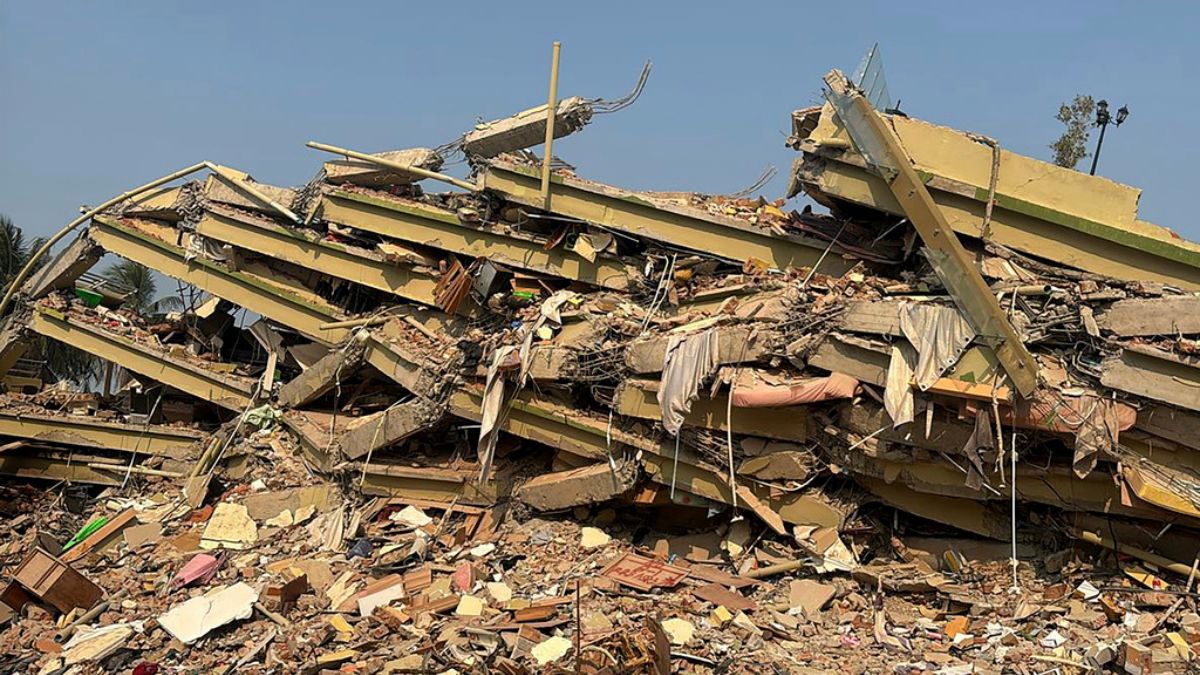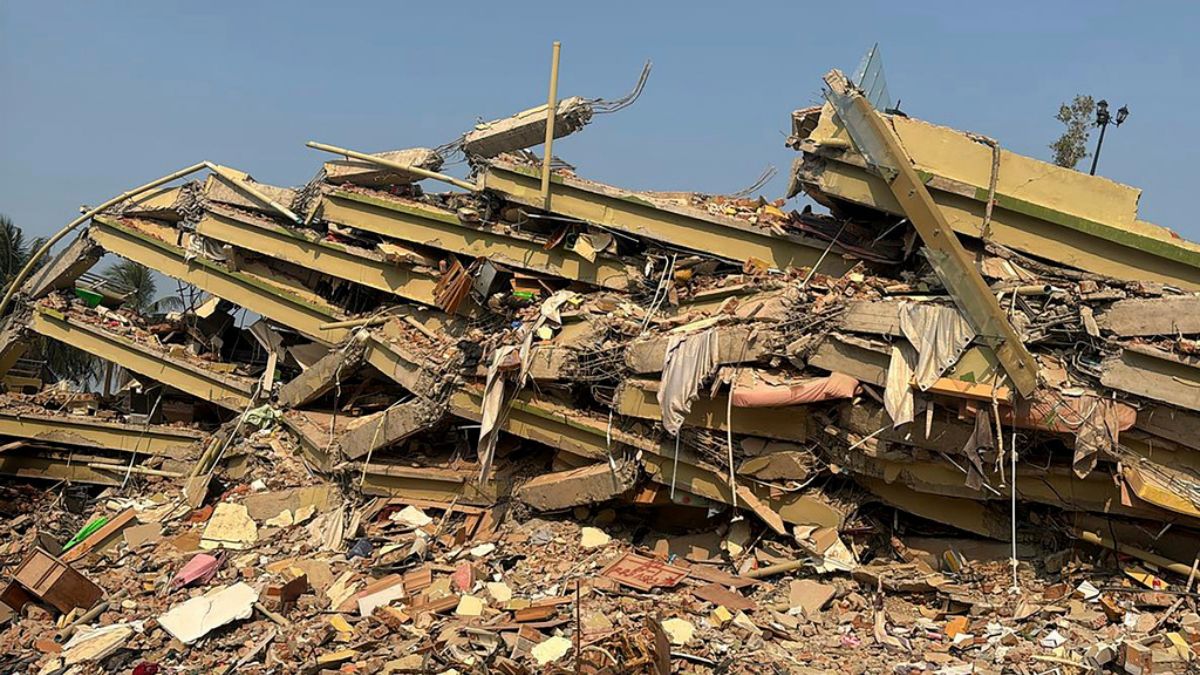Tremors from the 7.7-magnitude earthquake centred in Myanmar hit Thailand’s Bangkok on Friday afternoon.
Consequently, an under-construction 33-storey high-rise building in Chatuchak weekend market that is a magnet for tourists collapsed in seconds.
Thailand’s Deputy Prime Minister Anutin Charnvirakul has now ordered an immediate inquiry into the collapse.
A committee of experts has been established and given seven days to identify the cause.
But why did this building collapse under scrutiny? Let’s take a closer look.
The collapsed Bangkok Scraper
The unfinished high-rise structure collapsed in a matter of seconds, trapping hundreds of people beneath the debris and throwing a cloud of dust and debris into the air.
As of Sunday, as per an AFP report, 17 people were confirmed dead, 32 others were injured, and 83 others were unaccounted for, the majority of whom were construction workers.
Search and rescue teams are still searching for potential survivors in the sweltering heat. At least 15 persons who might still be alive have been found by thermal imaging drones. So far, eight bodies have been recovered from the wreckage.
Even though several high-rise structures were being built in Bangkok, no other projects experienced the same level of devastation.
Officials and experts are increasingly criticising the high-rise building’s strong foundation.
Its link with Chinese firm
It is reported that the collapsed structure was part of a project for Thailand’s State Audit Office (SAO) and had been under construction for three years at a cost of over two billion baht.
It was a joint venture between China Railway Number 10 (Thailand) Ltd. and Italian-Thai Development Plc (ITD).
According to Telegraph UK, the latter is a subsidiary of China Railway Number 10 Engineering Group Company, which owns a 49 per cent share, the highest amount of foreign ownership permitted by Thai law.
According to the report, China Railway Number 10 Thailand was founded in 2018 and has since worked as a contractor on major infrastructure projects, such as public highways, office buildings, and railroads.
In 2023, the business had a net loss of 199.66 million baht, with 206.25 million baht in revenue and 354.95 million baht in expenses.
Among its Thai owners are Sophon Meechai (40.80 per cent), who also owns shares in five other businesses; Prachuab Sirikhet (10.20 per cent), who has investments in six businesses; and Manas Sri-anant (less than one per cent), who has shares in 10 other companies.
Investigation ordered
An expert panel has been given seven days to ascertain the cause of the collapse by Thailand’s Deputy Prime Minister and Interior Minister Anutin Charnvirakul, who also called for an urgent probe.
An expert from China has been dispatched to examine the collapse site.
A team of seasoned engineers from the Department of Public Works and Town & Country Planning, along with trustworthy specialists, were assembled to conduct the inquiry, according to Bangkok Post.
“Thailand will quickly find out why the building collapsed. It was just built and should have been designed to withstand earthquakes,” the interior minister said, adding, “The earthquake caused a seismic magnitude of 7.8 but more than 95 per cent of buildings withstood it. Collapse happened only to the State Audit building. This building was newly constructed. So, it should have endured an earthquake."
According to Anutin, the probe will concentrate on builders, architects, and construction supervisors. The construction consortium’s Chinese and Thai partners would have to share responsibility.
Chinese nationals arrested
Four Chinese nationals were arrested by Thai police on Sunday for breaking into the location of the collapsed skyscraper.
According to a National Thailand report, which quoted Police Major General Nopasin Poolswat, Deputy Commissioner of the Metropolitan Police Bureau, four Chinese nationals were apprehended for unlawfully removing 32 files of documents from the back of the collapsed State Audit Office (SAO) building without authorisation.
Notably, the governor of Bangkok designated the area where the building collapsed as a disaster zone following the strong earthquake, making it a restricted area that no one was permitted to access without permission.
One of the Chinese men said he was in charge of a building construction project. He had valid work permit, and his company was working in a joint venture with the building’s contractor, Italian-Thai Development Public Company Limited.
The documents confiscated from the men were various types of paperwork, according to the National Thailand report.
They told the police they had gone into the area to collect documents, kept in a container at the company’s temporary office, required for an insurance claim.
The suspects were temporarily released by the police when the interrogation was over. However, later on Sunday, Chatuchak District Office officials filed a complaint against five Chinese nationals for visiting the construction site and taking blueprints and other documents from the SAO building that had collapsed, in violation of the public statement.
The four men’s employer, the fifth person, is also being investigated.
Myanmar earthquake
The 7.7-magnitude quake, one of Myanmar’s strongest in a century, jolted the war-torn Southeast Asian nation on Friday, leaving around 1,700 people dead, 3,400 injured and over 300 missing as of Sunday, according to Reuters.
Originating northwest of Sagaing, the tremors destroyed infrastructure and buildings throughout Mandalay, one of the biggest cities in Myanmar.
Power shortages hindered rescue attempts in Mandalay, where many people are still buried in building wreckage, according to Al Jazeera.
Moreover, anti-coup fighters in Myanmar declared a two-week ceasefire to aid earthquake victims.
The junta chief, Senior General Min Aung Hlaing, warned that the number of fatalities could rise, state media reported, three days after he made a rare call for international assistance. The country has declared a state of emergency across six regions, and hospitals are overwhelmed with casualties.
India, China and Thailand are among Myanmar’s neighbours that have sent relief materials and teams, along with aid and personnel from Malaysia, Singapore and Russia.
The United States pledged $2 million in aid “through Myanmar-based humanitarian assistance organizations” and said in a statement that an emergency response team from USAID, which is undergoing massive cuts under the Trump administration, is deploying to Myanmar.
With inputs from agencies


)
)
)
)
)
)
)
)
)



